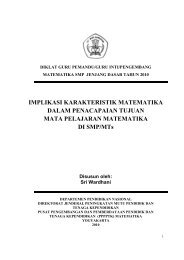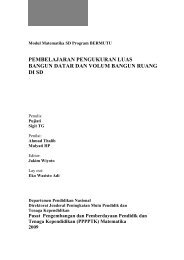25 Biggest Mistakes Teachers Make and How to Avoid Them
25 Biggest Mistakes Teachers Make and How to Avoid Them
25 Biggest Mistakes Teachers Make and How to Avoid Them
You also want an ePaper? Increase the reach of your titles
YUMPU automatically turns print PDFs into web optimized ePapers that Google loves.
Mistake 11: Humiliation<br />
what the coach intended. He was<br />
using shame as a motiva<strong>to</strong>r <strong>to</strong> get the<br />
student <strong>to</strong> do the required number of<br />
pull-ups.<br />
Sensitive, knowledgeable teachers<br />
know that shame is not a motiva<strong>to</strong>r;<br />
in fact, shame can be an inhibi<strong>to</strong>r.<br />
Children can internalize shame <strong>and</strong><br />
continue <strong>to</strong> feel its effects in<strong>to</strong> adulthood.<br />
Good teachers would first rule<br />
out any physical reasons that the<br />
student could not perform the pullups.<br />
Next, they might use a multiple<br />
SCENARIO 11.3<br />
Shake, Baby, Shake<br />
intelligences approach in teaching the<br />
student <strong>to</strong> do pull-ups (Campbell,<br />
Campbell, & Dickinson, 1996). Using<br />
this approach, teachers must believe<br />
that students have strengths across<br />
content areas <strong>and</strong> must encourage<br />
them <strong>to</strong> pursue those strengths while<br />
minimizing their weaknesses. If the<br />
student does not have the arm<br />
strength <strong>to</strong> engage in pull-ups, perhaps<br />
she can improve her arm strength<br />
by lifting weights or by working out<br />
on a rowing machine.<br />
My worst experience was in second grade. My teacher would grab us by the arms, shake us,<br />
<strong>and</strong> get right in our face <strong>and</strong> yell at us. I remember being so embarrassed after she did this.<br />
She yelled at me because I was crying about having no friends; boy that really helped. NOT!<br />
The same dynamics that underlie<br />
shaken baby syndrome<br />
(Lancon, Haines, & Parent, 1998) are<br />
present in this scenario. In shaken<br />
baby syndrome, caregivers become<br />
very frustrated in their efforts <strong>to</strong> console<br />
or quiet a crying child. They resort<br />
<strong>to</strong> grabbing the child by the shoulders<br />
<strong>and</strong> shaking her back <strong>and</strong> forth in such<br />
a way that her brain hits the inside of<br />
her skull. The child may suffer a serious<br />
injury <strong>and</strong>, in some cases, death.<br />
In this scenario, the teacher’s<br />
actions were the same but the prognosis<br />
is better because the children were<br />
older <strong>and</strong> the shaking was milder. The<br />
teacher did grab the child <strong>and</strong> shake<br />
her. The child’s crying triggered the<br />
teacher’s actions. The teacher apparently<br />
lost control <strong>and</strong> started yelling.<br />
There was no sympathy for the child’s<br />
friendless plight, only humiliation.<br />
Effective teachers would try <strong>to</strong><br />
find out why the child is crying rather<br />
than try <strong>to</strong> suppress the crying<br />
through humiliation <strong>and</strong> physical<br />
aggression. If they find that they cannot<br />
console a child, they know that it’s<br />
okay <strong>to</strong> let the child cry. Perceptive<br />
teachers use sociograms (McConnell<br />
& Odom, 1986) <strong>to</strong> ascertain student<br />
popularity, student cliques <strong>and</strong><br />
friendships, <strong>and</strong> students who are<br />
social isolates. Once they are aware of<br />
the unpopular or isolated students,<br />
they can make efforts <strong>to</strong> help those<br />
students. One strategy might be <strong>to</strong><br />
pair students <strong>to</strong> work <strong>to</strong>gether <strong>to</strong><br />
pave the way for friendship. Good<br />
teachers might offer one-on-one help<br />
sessions on how <strong>to</strong> make friends. A<br />
foolproof strategy for making a friend<br />
is for the teacher <strong>to</strong> volunteer <strong>to</strong> be the<br />
child’s first friend.<br />
73





